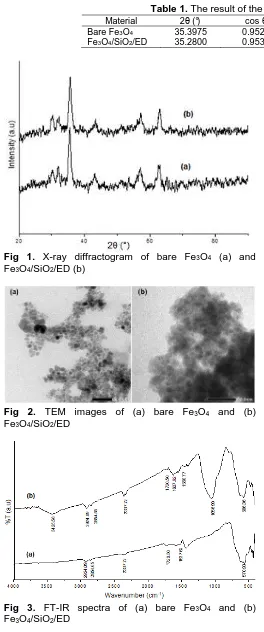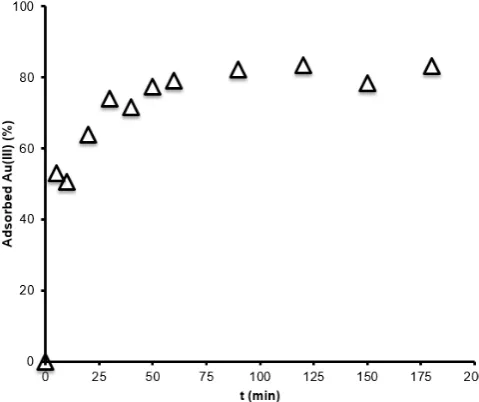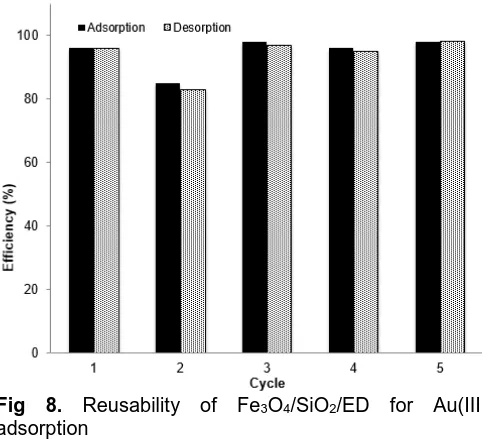Nuryono et al.
* Corresponding author. Tel/Fax : +62-274-545188 Email address: nuryono_mipa@ugm.ac.id
Functionalization of Fe
3O
4/SiO
2with N-(2-Aminoethyl)-3-aminopropyl
for Sorption of [AuCl
4]
-Nuryono
1,*, Mighfar Syukur
1, Agus Kuncaka
1, and Satya Candra Wibawa Sakti
21Department of Chemistry, Faculty of Mathematics and Natural Sciences, Universitas Gadjah Mada
Sekip Utara, Yogyakarta 55281, Indonesia
2Laboratory of Environmental Analysis and Remediation, Graduate School of Environmental Science
Hokkaido University, Kita-ku, Kita 10, Nishi 5, 060-08107 Sapporo-shi, Japan
Received December 21, 2015; Accepted April 10, 2016
ABSTRACT
Synthesis of Fe3O4/SiO2 modified with N-(2-aminoethyl)-3-aminopropyl group (Fe3O4/SiO2/ED) via coating
method and its application for adsorption-desorption of anionic gold in aqueous solution have been conducted. The synthesized product was characterized with an X-ray diffractometer (XRD), a Fourier transform infrared (FT-IR) spectrophotometer and a transmission electron microscopy (TEM). Adsorption of Au(III) was conducted in a batch system and the variables included pH, contact time, and initial concentration were investigated. Results showed that magnetite/silica has been successfully functionalized with N-(2-aminoethyl)-3-aminopropyl in a homogeneous system. Kinetics study showed that adsorption of Au(III) followed the pseudo-second order model with rate constant of 0.710 g mmol L-1min-1. Furthermore, the experimental data fitted well with the Langmuir isotherm model with the
maximum adsorption capacity for Au(III) of 142.9 mg g-1 and the energy of 25.0 kJ mol-1. Gold loaded on the
Fe3O4/SiO2/ED could be easily desorbed with 0.2 mol L-1 HCl containing 2 wt.% of thiourea with recovery of 99.8%.
Fe3O4/SiO2/ED was reusable and stable in 5 cycles of adsorption-desorption with recovery more than 90%.
Fe3O4/SiO2/ED showed high selectivity towards Au(III) in the multimetal system Au(III)/Cu(II)/Cr(VI) with the
coefficient selectivity for αAu-Cu of 227.5and for αAu-Cr of 12.3.
Keywords: adsorption; gold; magnetite; silica
ABSTRAK
Sintesis Fe3O4/SiO2 termodifikasi dengan gugus N-(2aminoetil)-3-aminopropil (Fe3O4/SiO2/ED) menggunakan
metode pelapisan dan aplikasinya untuk adsorpsi-desorpsi ion emas dalam larutan air telah berhasil dilakukan. Produk hasil sintesis dikarakterisasi menggunakan difraktometer sinar-X (XRD), spektrofotometer inframerah (FTIR) dan mikroskop transmisi elektron (TEM). Adsorpsi ion Au(III) dilakukan dalam sistem batch dan variabel-variabel meliputi pH, waktu kontak dan konsentrasi awal telah diteliti. Hasil penelitian menunjukkan bahwa magnetit/silika telah berhasil difungsionalisasi menggunakan N-(2aminoetil)-3-aminopropil dalam sistem homogen. Studi kinetik menunjukkan bahwa adsorpsi Au(III) mengikuti model pseudo-orde dua dengan konstanta laju 0,710 g mmol L-1min -1. Selain itu, data percobaan sesuai dengan model isoterm langmuir dengan kapasitas adsorpsi maksimum untuk ion
Au(III) sebesar 142.9 mg g-1 dan energi sebesar 25.0 kJ mol-1. Emas yang terisi pada Fe
3O4/SiO2/ED dapat
didesorpsi dengan mudah menggunakan thiourea 2 w/w dalam HCl 0.2 mol L-1 dengan perolehan kembali sebesar
99,8%. Fe3O4/SiO2/ED stabil dan dapat digunakan secara berulang proses adsorpsi-desorpsi hingga 5 kali dengan
perolehan kembali lebih dari 90%. Fe3O4/SiO2/ED selektif terhadap Au(III) didalam sistem multilogam
Au(III)/Cu(II)/Cr(VI) dengan koefisien selektifitas untuk αAu-Cu sebesar 227,5dan untuk αAu-Cr sebesar12,3.
Kata Kunci: adsorpsi; emas; magnetit; silika
INTRODUCTION
Gold is one commodity of the precious metals that has relatively high economic value and interested to be explorated [1]. In nature, gold has founded on metal form either in the rock cracks or in mineral quartz. The relative
abundance of gold in the earth’s crust is 0.004 g tonne-1
which includes 0.001 g tonne-1 in seawater [2]. The
Nuryono et al.
purification process using cyanide [3] and amalgamation with mercury [4]. Cyanide is widely used because it is relatively cheap and the isolation process is relatively short and simple.
Even though, there are several methods of gold recovery, such as ion exchange, liquid-liquid extraction, membrane filtration and adsorption, available in the literature for the removal of precious metals from aqueous solutions, comparatively, adsorption seems to be the most suitable method for the recovery of precious metals in the case of low concentration due to low cost and high efficiency [5]. The gold adsorption methods was developed with solid inorganic adsorbent of silica gel [6,7]. This adsorbent has a large surface area and is easy to be modified, but its adsorption capacity is relatively low so further modification with certain functional groups such as –NH2 [7], –SH [8] and -SO3H
[9] is needed groups.
The surface modification of mesoporous silica with amino group (-NH2) has performed in order to increase
the performance of adsorption of precious metals [8]. At pH < 4.7 that functional group is protonated to form cation –NH3+. On the other hand gold ions in solution of
chloride form anion of [AuCl4]-; hence both ions may
interact electrostatically and adsorption occurs [10]. Attempt to improve the adsorption performance multifunctional groups has been introduced. Introducing ethylenediamine on the surface of the adsorbent is predicted to increase the capability in adsorbing gold ion.
Recently, in order to simplify the separation of adsorbate and adsorbent from the solution, magnetic material such ash magnetite (Fe3O4) has been
introduced to adsorbent; hence the adsorbent could be attracted with an external magnet and separated from the solutions easily. After reaching the equilibrium stage, the gold(III) on the surface of adsorbent is desorbed by contacting with a leaching agent such as cyanide solution. However it’s low desorption rate and toxicity made cyanide less favorable as a leaching agent [11]. Based on the environmental problems, environmentally friendly solvents is required for desorption of gold from the adsorbent.
In this paper we report synthesis of magnetite coated with N-(2-Aminoethyl)-3-aminopropyl (ethylene diaminopropyl) modified silica and evaluation of adsorption characteristics towards gold(III). Due to the presence of magnetite particle, the adsorbent could be separated easily from the mixture. Additionally, desorption of Au(III) from magnetic adsorbent using thiourea in HCl solution as a leaching agent has been investigated, as well as the possibility of adsorbent for pre-concentration of Au(III) in very low concentration solution.
EXPERIMENTAL SECTION
Materials
Iron chloride (FeCl3·6H2O and FeCl2·4H2O),
thiourea, standard solution of HAuCl4 1000 mg L-1 were
supplied from Merck-Millipore. Sodium silicate (Na2SiO3) solution with the concentration of SiO2 13
wt.% as precursor was produced from rice husk. N-(2-aminoethyl)-3-aminopropyltrimethoxy-silane (EDS) from Aldrich was used without previous treatment. The solution of HAuCl4 500 mg L-1 from Analytical chemistry
Lab was used as stock Au(III) solution. Several
magnetite coated with ethylenediaminopropyl modified silica (Fe3O4/SiO2/ED) were characterized using a
X-Ray Diffractometer (XRD Shimadzu 6000) and a Transmission Electron Microscope (TEM JEM 1400 JEOL/EO). The Fourier Transform Infrared (FTIR) spectra were collected in KBr disc on SHIMADZU IR 8210 PC. The amount of adsorbed Au(III) on Fe3O4/SiO2/ED was measured with an Atomic
Absorption Spectrophotometer (Aspect CS contrAA Analytic Jena 300). The existence of Au(III) was characterized with XRD.
Procedure
Synthesis of magnetite Fe3O4
Magnetic material Fe3O4 was prepared by
co-precipitation as reported by Hou et al. [12]. FeCl3·6H2O
Nuryono et al. analyzed with an atomic absorption spectrophotometer (AAS). The amount of Au(III) ion adsorbed was
concentration of the metal ions (mmol L–1), respectively;
W is the mass of the adsorbent (g), and V is the volume of the metal ion solution (L). The pH was adjusted and varied from 1.0 to 6.0 with CH3COONa-HCl buffer
solution. An analogue work of the adsorption was carried out by varying contact time (from 5 to 60 min) at constant pH to study the kinetics of the adsorption. Two kinetics models (pseudo-first order, and pseudo-second order), were applied and the rate constants were calculated. Additionally, adsorption in various concentrations of Au(III), in a range of 25–300 mg L–1 at
constant pH and contact time was conducted, as well. The experimental data were evaluated using Langmuir and Freundlich isotherm models to calculate the adsorption capacity.
Desorption of Au(III) from Fe3O4/SiO2/ED
Gold(III) adsorption experiments were performed from Fe3O4/SiO2/ED to the solution of 50 mg L-1 HAuCl4
in buffered solution (pH = 3) and equilibrated with a shaker at room temperature for 50 min. The adsorbent was then leached with solution of thiourea 2% in different various concentrations of HCl solution for 5 min. After leaching, the amount of Au(III) desorbed was determined with AAS.
Preconcentration of Au(III) with Fe3O4/SiO2/ED
Fe3O4/SiO2/ED (10 mg) was added to the solution
of 10 mg L-1 HAuCl4 in a buffered solution (pH = 3) at
various volumes (20, 40, 60, 80, 100, and 120 mL) and equilibrated with a shaker at a room temperature for 50 min. The adsorbent was separated from the solution using an external magnet and contacted with 10 mL of 9 wt.% thiourea in 0.1 mol L-1 HCl for 50 min in order to
desorb the Au(III) ion. After desorption, the recovered Au(III) was calculated and the preconcentration factor for Au(III) on Fe3O4/SiO2/ED was obtained.
Reusability of Fe3O4/SiO2/ED
Repeated adsorption-desorption steps were conducted to examine the reusability of Fe3O4/SiO2/ED.
The Fe3O4/SiO2/ED (10 mg) was equilibrated with 10 the final solution of 20 mL of 3 wt.% thiourea in 0.1 mol L-1 HCl.
Selectivity of Fe3O4/SiO2/ED
The selectivity of Fe3O4/SiO2/ED towards Au(III)
ion was evaluated in the presence of Cu(II) and Cr(VI) ions with various concentrations. The selectivity coefficient and the relative selectivity coefficient were calculated using Eq. 2.
Effect of silica coating on crystallinity of magnetite can be evaluated based on the XRD pattern presented in Fig. 1. In Fig. 1 XRD pattern of Fe3O4 can be
observed five specific peaks at 2θ = 30.08°; 35.43°;
43.08°; 56.97°; and 62.57° which the specific peaks from magnetite. It was indicated that magnetite Fe3O4
has been synthesized successfully. Fig. 1 also showed the intensity of XRD pattern of Fe3O4/SiO2/ED
indicating compatibility with XRD pattern of bare Fe3O4,
and it supports result reported by Lin et al. [14] that coating does not change the structure of magnetite. Furthermore, the particle size with a certain phase can be determined from the data of XRD. The result of the particle size calculations are presented in Table 1.
As shown in Table 1, the particle size of 2a, TEM micrograph of bare Fe3O4 indicatesthat some
Nuryono et al.
Table 1. The result of the particle size calculations
Material 2θ (°) cos θ FWHM (rad) DXRD (nm)
Bare Fe3O4 35.3975 0.9527 0.0120 10.4586 ± 1.14
Fe3O4/SiO2/ED 35.2800 0.9530 0.0091 14.2897 ± 2.82
Fig 1. X-ray diffractogram of bare Fe3O4 (a) and
Fe3O4/SiO2/ED (b)
Fig 2. TEM images of (a) bare Fe3O4 and (b)
Fe3O4/SiO2/ED
Fig 3. FT-IR spectra of (a) bare Fe3O4 and (b)
Fe3O4/SiO2/ED
particles size at 9.0-12.0 nm. TEM micrograph of Fe3O4/SiO2/ED (Fig. 2b) shown that the particles are
more clustered with the particles size at 17.0–19.0 nm. The presence of silica and functional groups on magnetite may form some new bonds, which can be characterized using a FT-IR spectroscopy and the result is expressed in Fig. 3. As can be seen in Fig. 3 IR spectra of bare Fe3O4 gives a characteristic band at
around 586.36 cm-1 from Fe-O stretching [15].
Additionally, a band at around 2924.09 cm-1 that
indicates -CH2- stretching from oleic acid is also
observed [16]. FT-IR spectra of Fe3O4/SiO2/ED gives
broad strong bands at 1072 and 3449 cm-1 which
indicates stretching mode for Si-O-Si [15, 17] and O-H/N-H [18], respectively. The presence of ED groups is indicated from strong bands at 1087.85 and 2939.52 cm-1, which are characteristic for Si-O, and
–CH2- stretching mode, respectively [18].
Adsorption Au(III) on Fe3O4/SiO2/ED
Adsorption isotherm
As shown in Fig. 4, the adsorption of Au(III) on Fe3O4/SiO2/ED increase as the initial concentration
increase and reaches the equilibrium stage at initial Au(III) concentration of 250 mg L-1. Based on the
correlation of Au(III) at equilibrium with adsorbed Au(III), two isotherm models (Langmuir and Freundlich) are used to evaluate the adsorption capacity and the adsorption energy of Au (III) on Fe3O4/SiO2/ED. The
results of calculation of these parameters are presented in Table 2. Based on Table 2, the R2 value
showed that the experimental data of adsorption Au(III) are fit well with the Langmuir isotherm model. The energy of adsorption is 25 kJ mol-1 which is categorized
as chemisorption [19].
Adsorption kinetics
Evaluation of adsorption kinetics is evaluated based on the adsorption data of Au(III) at variation of contact time in a time range of 0-180 min which expressed in Fig. 5.
Nuryono et al.
Fig 4. Influence of Au(III) initial concentration on Au(III) adsorption onto Fe3O4/SiO2/ED (Conditions: adsorbent
dose: 1.0 g L-1; pH: 3 and contact time: 50 min)
Fig 5. Effect of contact time on adsorption of Au(III) by Fe3O4/SiO2/ED (Conditions: adsorbent dose: 1.0 g L-1;
pH: 3 and initial Au(III) concentration: 100 mg L-1)
Table 2. The Langmuir and Freundlich isotherm models parameter for adsorption of Au(III) adsorption by Fe3O4/SiO2/ED
Isotherm Langmuir Isotherm Freundlich
Qmax
(mg g-1)
KL
(L mg-1) R2
E (kJ mol-1)
KF
(mg g-1 (L/mg)1/n) n R2
142.857 0.125 0.996 25.052 37.497 4.219 0.687
Table 3. Kinetics parameters for adsorption Au(III) by Fe3O4/SiO2/ED
Kinetics model Adsorption rate constant (k) R2
Order 1 0.001 min-1 0.567
Order 2 0.066 mM-1min-1 0.692
Pseudo order-1 0.028 min-1 0.954
Pseudo order-2 0.710 g mM-1min-1 0.996
1 0
e
lnC k t lnC (3)
2 0
1 1
e
k t
C C (4)
1log qeqt log qek tP / 2.303 (5)
2 2
1/qt 1/k qP et q/ e (6)
where Ce and C0 are the concentration of Au(III) at
equilibrium and initial time, qe and qt are the amounts of
Au(III) adsorbed at equilibrium and time t, respectively; and k1, k2, kP1 and kP2 are adsorption rate constants for
first-order, second order, first-order and pseudo-second-order kinetics, respectively. The adsorption rate constant and linearity of each model are shown in Table 3.
From four selected models in Table 3 is observed that adsorption of Au(III) on investigated adsorbents tends to follow pseudo-second-order kinetic model. The presence of high concentration of chloride ions in the solution gives a chance of either proton or anion from
the solution to involve in the adsorption. Another possibility is that the number of the active sites on adsorbent after and before adsorption is not significantly different since the concentration of metal ions is considered very low.
Desorption of Au(III) for Fe3O4/SiO2/ED
As shown in Fig. 6a, the desorption of Au(III) from Fe3O4/SiO2/ED slightly increases as the concentration
of HCl increase. The increase of the amount of Au(III) desorbed from Fe3O4/SiO2/ED is due to the existence
of ion H+ in solution that can stabilize thiourea and
prevent the degradation leadings to decrease the consumption of thiourea [22]. Additionally, Cl- ion from
HCl has a function as competitor for the Au(III) complexes [23]. As shown in Fig. 6b, amount of degraded Fe3O4/SiO2/ED increases as the
Nuryono et al.
Fig 6. Desorption of Au(III) from Fe3O4/SiO2/ED (a) and
degraded Fe3O4/SiO2/ED in 2 wt.% thiourea with
different concentration of HCl (b)
Fig 7. Recovery of Au(III) by Fe3O4/SiO2/ED (Condition:
adsorbent: 10 mg, Initial Au(III) concentration: 10 mg L -1, adsorption and desorption time: 50 min)
Fig 8. Reusability of Fe3O4/SiO2/ED for Au(III)
adsorption
5% of Fe3O4/SiO2/ED is degradated. This result indicates
that the Fe3O4/SiO2/ED is relatively stable during
desorption processes.
Preconcentration of Au(III) Using Fe3O4/Sio2/ED
As shown in Fig. 7, Au(III) on Fe3O4/SiO2/ED can
be quantitatively recovered when the sample volume was less than 400 mL. When the sample volume is more than 400 mL, the recovery decreases. Consequently, by considering the final elution volume of 1.0 mL of 9 wt.% thiourea in 0.1 mol L-1 HCl, a preconcentration factor of
40 was easily achieved.
Reusability of Fe3O4/SiO2/ED for Sorption of Au(III)
As shown in Fig. 8, almost all of Au(III) in the solution was removed and could be recovered quantitatively. Besides, almost all of Fe3O4/SiO2/ED
could be recollected easily using an external magnet which indicates that Fe3O4/SiO2/ED can be used for
adsorption of Au(III) repeatedly without any significant loss on its performance.
Nuryono et al.
Table 4. Selectivity of Fe3O4/SiO2/ED for Au(III) adsorption toward Cu(II) and Cr(VI)
Co (mM) D (L g-1)
from multimetal ion system was evaluated by adsorbing Au(III) in multimetal ion system at constant concentration of Au(III) and various concentrations of other metal ions. Selectivity was presented as a ratio of coefficient distribution calculated using Eq. (2) and the result can be seen in Table 4. Based on Table 4, selectivity coefficient of Au(III) toward Cu(II) and Cr(VI) is high which indicates that Fe3O4/SiO2/ED has a high selectivity towards Au(III)
in the presence of Cu(III) and Cr(VI).
CONCLUSION
Functionalization of Fe3O4/SiO2 with
N-(2-Aminoethyl)-3-aminopropyl to obtain Fe3O4/SiO2/ED
has been successfully conducted. The performance of Fe3O4/SiO2/ED as an adsorbent for Au(III) in aqueous
any significant loss on its performance.
ACKNOWLEDGEMENT
The authors are very thankful to the Directorate of Research and Community Services, Ministry of Research Technology and Higher Education, Republic of Indonesia through Research Grant Penelitian Unggulan Perguruan Tinggi (PUPT) UGM, No. 53/LPPM/2015, for providing the research budget.
REFERENCES
1. Syed, S., 2012, Hydrometallurgy, 115-116, 30–51. 2. Koyanaka, H., Takeuchi, K., and Loong, C.K.,
2005, Sep. Purif. Technol., 43 (1), 9–15.
3. Hiskey, J. B., 1985, Gold and Silver Extraction: the Application of Heap-Leaching Cyanidation, Arizona T., and Ueda, K., 2008, Bioresour. Technol., 99 (9), 3801–3809. Pereira, C.J., 2011, Hydrometallurgy, 57 (1), 1–11. 12. Hou, Y., Yu, J., and Gao, S., 2003, J. Mater.
Chem., 13 (8), 1983–1987.
13. Nuryono, Rosiati, M., Rusdiarso, B., Sakti, S.C.W., and Tanaka, S., 2014, SpringerPlus, 3, 1–12. 14. Lin, Y., Chen, H., Lin, K., Chen, B., and Chiou, C.,
17. Widjonarko, D.M., Jumina, Kartini, I., and Nuryono, 2014, Indones. J. Chem., 14, 2, 143–151.
Nuryono et al.
19. Khezami, L., and Capart, R., 2005, J. Hazard. Mater., 123 (1), 223–231.
20. Huang, G., Zhang, H., Shi, J.X., and Langrish, T.A.G., 2009, Ind. Eng. Chem. Res., 48 (5), 2646– 2651.
21. Shih, M.C., 2012, Desalin. Water Treat., 37 (1-3), 200–214.
22. Li, J., Xu, X., and Liu, W., 2012, Waste Manage., 32 (6), 1209–1212.



